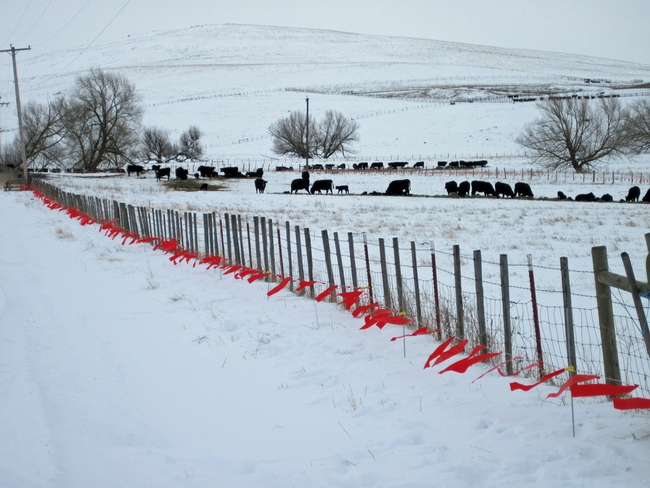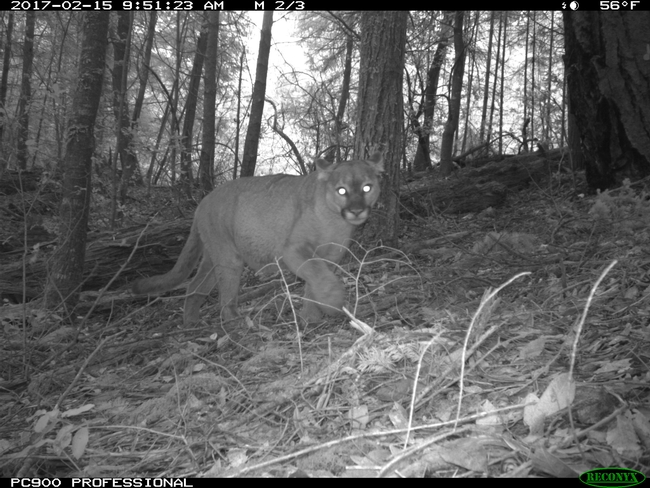Note: this is the second in a series of posts on nonlethal livestock protection tools. Click here to see the first in the series. Both posts are adapted from:
Macon, D.K, R.A. Baldwin, D.F. Lile, J. Stackhouse, C.K. Rivers, T. Saitone, T.K. Schohr, L.K. Snell, J. Harper, R. Ingram, K. Rodrigues, L. Macaulay, and L.M. Roche. IN PRESS. Livestock protection tools for California ranchers. Oakland: University of California Division of Agriculture and Natural Resources Publication 8598 (in press).
Livestock death loss to predators is typically much lower than loss from disease and natural causes (based on USDA data and my own surveys of California ranchers). Even so, predators can present significant localized challenges – and for many ranchers, a single loss to a predator may be one too many. As I mentioned in my previous post, indirect losses (mostly stress-induced production problems and added labor) may be more significant in economic terms than death losses (see Ramler et al. 2014).
For me, as a small-scale sheep producer, livestock protection tools are important for a number of reasons in addition to preventing death losses. Since we graze our sheep on rangelands and pastures that are 3-10 miles from our home, I can't watch them 24-7. Livestock protection tools can alter human behavior, alter livestock husbandry practices, alter predator behavior and/or provide disruptive or aversive stimuli to predators (Shivik 2004). As with any management tool, my selection of specific nonlethal tools depends on efficacy, cost-benefit considerations, public perceptions (including market forces that may increase demand for predator coexistence), and my own attitudes toward and confidence in the methods.
In this post, we'll examine several tools that have been suggested for use in wolf country. As with the tools I discussed last week (guardian animals and electric temporary electric fencing), the efficacy of these tools depends on a number of the factors outlined above.
Attractant Removal: Many predators are also opportunistic scavengers; therefore, a dead animal may attract predators into an area currently being grazed by livestock. Attractant removal involves the removal and disposal of dead livestock, as well as the removal of sick or injured livestock. These strategies can reduce attraction to areas used by livestock and may avoid giving predators a taste for livestock (Wilbanks 1995). Observational evidence in the northern Rocky Mountains and on the Modoc Plateau suggests wolves that are attracted to bone yards may be more likely to kill cattle or sheep in adjacent areas (T. Kaminski, pers. comm., 2016). Bone yards may also attract livestock guardian dogs away from the livestock they are protecting (N. East, pers. comm., 2016).
Anyone who's tried to dispose of the carcass of a 2000-pound bull that managed to die 15 miles from the nearest dirt road will know that this tool presents a number of logistical challenges. Many times, we don't find a carcass before it's discovered by scavengers. Even if we can get the carcass to the road, the cost of transport and disposal in a rendering facility may be cost prohibitive. Burying livestock carcasses is currently legally prohibited in California (Antonelli et al. 2016), as is the composting of mammalian flesh (CalRecycle 2017). In light of these challenges, ranchers might consider moving a carcass as far away from livestock as possible.
Fladry or Turbo Fladry: Believe it nor not, flapping flags hung at the right height can deter wolves. Fladry is a series of cloth or plastic flags attached to a rope or wire that creates a novel visual stimulus wolves find uniquely frightening (Bangs et al. 2006). Over time, wolves may become habituated to fladry, willingly crossing fladry barriers to kill livestock (Musiani et al. 2003). This study also found that fladry may push wolves to neighboring ranches or unprotected pastures. Turbo fladry (electrified poly-wire with flags, powered by a standard electric fence energizer) may be as much as 2 to 10 times more effective than non-electrified barriers (Lance et al. 2010). I would think that fladry may be a useful tool in smaller-scale pasture settings (e.g., heifer calving pastures or sheep bedding grounds). Fladry may not be an effective deterrent for predators other than wolves (Davidson-Nelson and Gehring 2010), although one study has suggested fladry may deter coyotes as well (Young et al. 2015a). If you want to try turbo fladry, USDA Wildlife Services has several miles of it available to loan to ranchers – call the Wildlife Services state office at (916) 979-2675 for more information.
Night Penning: Night penning is exactly what it sounds like – it involves bringing livestock into a secure pen at night. Night penning (and to a lesser extent, simply night gathering) sheep can be effective in reducing wolf predation, especially when used in conjunction with livestock guardian dogs and/or human presence (Espuno et al. 2004). While night penning can provide protection during vulnerable periods, it comes at the cost of additional labor and facility construction and maintenance (Wilbanks 1995). In my experience, night penning works with small groups of animals (for 4-H or FFA projects, for example); it simply isn't practical in extensive operations.
Alarms/Scare Devices: Some predators seem to be afraid of novel stimuli. Strobe lights, propane cannons, and siren devices (including radio- and motion-activated guard devices) may temporarily displace or confuse predators (Bangs et al. 2006). Early research into battery-operated strobe or siren devices in fenced-pasture sheep operations across the western United States found that these devices deterred coyotes for up to 91 days and reduced lamb losses an estimated 44 to 95% (Linhart 1984; Linhart et al. 1992). However, habituation can be a problem if these devices are randomly—rather than behaviorally—activated (Shivik and Martin 2001). On the other hand, preliminary research at the University of California Hopland Research and Extension Center (Mendocino County) indicated mixed results with a new type of strobe light that emits random patterns of flashing light (trademarked as FoxLights). While initial results suggest FoxLights may be effective in deterring fox predation, the data collected so far do not support hypotheses of reduced livestock predation by coyotes, black bears, or mountain lions (McInturff et al. 2016).
In my next post, I'll discuss research and personal experience regarding the effectiveness of human presence (herders or range riders), as well as the importance of adapting these strategies to changing conditions. I hope others will share their experiences with these tools, as well!
Be sure to check out the Livestock-Predator Information Hub at http://rangelands.ucdavis.edu/predator-hub/!
